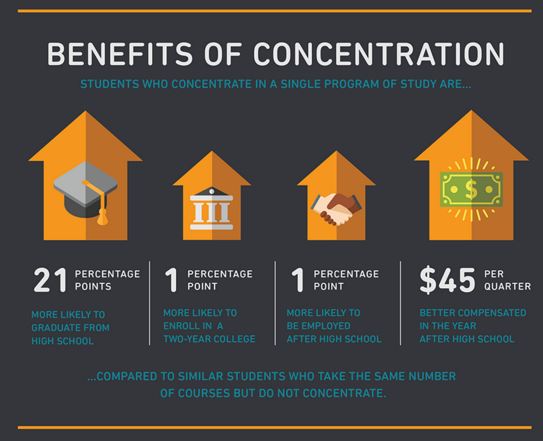We have compiled a list of highlights in Career Technical Education (CTE) from this week to share with you.
VIRTUAL CONFERENCE OF THE WEEK
Nebraska Career and Technical Education (CTE) held a Virtual Symposium, which was the first of its kind for the state. There were more than 700 CTE district, state and national level attendees. Among them were Commissioner Matt Blomstedt and Scott Stump, U.S. Assistant Secretary for Career, Technical, and Adult Education for the Office of Career, Technical and Adult Education.
During the symposium, winners of the annual Nebraska Excellence in Career and Technical Education Awards and Richard Katt Outstanding Nebraska Career and Technical Educators Awards were announced. Read more about the symposium and learn more about the award winners here.
STUDENT OF THE WEEK
In Michigan, one student has shown great leadership by joining Governor Gretchen Whitmer’s Return to Learn Council. Dominic Gonzalez is one of the district’s dual enrollment learners, which allows him to attend a local community college and earn college credit while still in high school. Dominic will be tasked with providing Governor Whitmer and the council a student perspective of what returning to school should look like in the fall. Read more in the article published by The Detroit News.
VIDEO OF THE WEEK
Texas CTE students did not let graduation or the pandemic stop them from completing one meaningful project. Engineering and veterinary science students developed a prosthetic paw for a local puppy who suffered complications at birth. View this video for highlights from the project, prototypes of the prosthetic paw and the student’s stories.
LEGISLATIVE UPDATE OF THE WEEK
The U.S. Department of Education approved four more state plans under the Strengthening Career and Technical Education for the 21st Century Act (Perkins V): Arkansas, Mississippi, Nevada and Tennessee. 35 state plans are approved in total so far. Check out this chart to see which states have been approved, and links to the state plans.
RESOURCE OF THE WEEK
Launched in 2016, JPMorgan Chase & Co. New Skills for Youth is a $75 million, five-year global initiative aimed at transforming how cities and states ensure that young people are career ready. The local investments from across the world – Innovation Sites – aim to identify and implement the most promising ideas in career education, with a special focus on communities with the greatest needs. Over the past year, Advance CTE has released a series of snapshots documenting the progress of the local investments. This week, Advance CTE released the final two snapshots featuring investments in the Greater Washington Region and Germany.
Brittany Cannady, Digital Media Associate


 In Massachusetts, Career/Vocational Technical Education Schools (CVTE) are renowned for offering rigorous, high-quality programs of study across a variety of disciplines. While CVTE graduates have always experienced high rates of success academically and in their careers, state leaders in Massachusetts wanted to know whether these outcomes directly result from the CVTE model. In 2017, the Massachusetts Department of Elementary and Secondary Education partnered with Shaun Dougherty (at the time, a researcher at the University of Connecticut),
In Massachusetts, Career/Vocational Technical Education Schools (CVTE) are renowned for offering rigorous, high-quality programs of study across a variety of disciplines. While CVTE graduates have always experienced high rates of success academically and in their careers, state leaders in Massachusetts wanted to know whether these outcomes directly result from the CVTE model. In 2017, the Massachusetts Department of Elementary and Secondary Education partnered with Shaun Dougherty (at the time, a researcher at the University of Connecticut), 
 The points an institution receives in the formula for credential attainment are multiplied if the credentials are in Science, Technology, Engineering and Mathematics (STEM) or state-defined “high-demand” fields. Qualifying fields are designated by the the Arkansas Department of Higher Education and the Department of Workforce Services. The multiplier for STEM degrees is 3 points; the multiplier for degrees in high-demand fields is 1.5 points.
The points an institution receives in the formula for credential attainment are multiplied if the credentials are in Science, Technology, Engineering and Mathematics (STEM) or state-defined “high-demand” fields. Qualifying fields are designated by the the Arkansas Department of Higher Education and the Department of Workforce Services. The multiplier for STEM degrees is 3 points; the multiplier for degrees in high-demand fields is 1.5 points.  A little over one year ago, Advance CTE launched
A little over one year ago, Advance CTE launched  Career exploration and guidance have in the past been considered as services only for CTE students, and particularly for CTE students who are not considering attending a postsecondary institution. Now state leaders are working to change this misconception by promoting career advisement as an integral part of the educational process for all learners.
Career exploration and guidance have in the past been considered as services only for CTE students, and particularly for CTE students who are not considering attending a postsecondary institution. Now state leaders are working to change this misconception by promoting career advisement as an integral part of the educational process for all learners. 